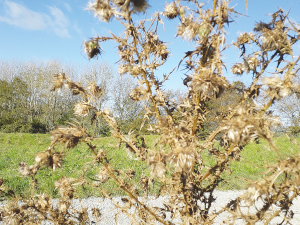Dairy power
OPINION: The good times felt across the dairy sector weren't lost at last week's Beef + Lamb NZ annual meeting.
 The Gaul Fly parasite was imported into New Zealand about 20 years ago to help control the spread of Scotch thistle.
The Gaul Fly parasite was imported into New Zealand about 20 years ago to help control the spread of Scotch thistle.
The Gaul Fly parasite was imported into New Zealand about 20 years ago by our Wellsford/ Warkworth Beef and Lamb farm monitor group.
The late John Foster was the driving force behind this project and did the research into its origins and effectiveness. Local farmers helped with financial contributions for trial work to ensure that the fly would not target other plant species, especially natives.
Having given financial support, I was given thistle seed heads containing larvae, soon to emerge as adults and deposit eggs. They soon multiplied and in a few years and had spread throughout the district – up to at least 10km against the prevailing SW wind.
The Gaul fly is slightly smaller than a house fly and its colour varies from green to brown, probably varying with age. Six to eight flies will be seen on a mature plant and will deposit eggs on every flower and all buds. The larvae not only devour all developing seed, but also the inside of buds before the seeds form. They are very thorough and seem to cover all flowers and buds.
The fly also forms hard wood-like Gaul, varying in size from as large as a small marble, according to the number of larvae present.
Sadly, John died soon after they were released and with his departure, no-one thought to spread this parasite nationwide. I considered this parasite of value – to at least reduce the impact of this weed and eventually reduce chemical use – and decided to make this fly’s larvae available to farmers.
I offered farmers two small mesh bags containing thistle seed heads which carried larvae, to hang on fences, at a cost of $60 to cover costs – $30 of which was donated to the Red Cross. Over 50 farmers from every district around the country took up this offer and the Red Cross benefited by more than $1,500.
Now, after about 8 years, this parasite must be well established. The obvious evidence of the presence of the Gaul fly is the total absence of thistle down drifting overhead in the summer breezes.
After pine forests have been harvested in my area, the ground will be covered in thistles, after the accumulation of seed for decades. Farmers have noted the absence of clouds of seed bearing down from tens of thousands of plants.
Originally, I estimated that the larvae would destroy 90% of seed, now I believe that figure could be 100%. All parasites are great survivors and will never totally eliminate their food source. In the spring, some thistles flower normally before the flies emerge after the winter period. Isolated thistles may also not be found.
So how does this play out in the future? It is my belief that because the seed remains viable for over 30 years, scotch thistles will remain a problem for many years to come. However, the number of thistles should slowly decline as the bank of seed diminishes in the soil. Eventually, the only seed produced will be from plants that escape the attention of the fly. In about 30 years’ time a balance will occur between parasite and host, both at a low level, as occurs in much of nature.
I have noticed thistles with larvae in their seed heads in parts of the country where I did not expect to find them. The larvae may have been in the thistle head in hay bales or carried by sheep in their wool.
We are no longer prepared to supply larvae, but there should now be plenty of thistles in the countryside that have the larvae of this parasite. The plants are fairly obvious as the flowers are malformed and will have very hard seed heads containing Gauls.
I have had no feedback from those that were sent seed heads and would like to know the success rate. My email address is This email address is being protected from spambots. You need JavaScript enabled to view it.
Gordon Levet is a well known ram breeder and farmer based in Northland.
Three New Zealand agritech companies are set to join forces to help unlock the full potential of technology.
As the sector heads into the traditional peak period for injuries and fatalities, farmers are being urged to "take a moment".
Federated Farmers says almost 2000 farmers have signed a petition launched this month to urge the Government to step in and provide certainty while the badly broken resource consent system is fixed.
Zespri’s counter-seasonal Zespri Global Supply (ZGS) programme is underway with approximately 33 million trays, or 118,800 tonnes, expected this year from orchards throughout France, Italy, Greece, Korea, and Japan.
Animal owners can help protect life-saving antibiotics from resistant bacteria by keeping their animals healthy, says the New Zealand Veterinary Association.
According to analysis by the Meat Industry Association (MIA), New Zealand red meat exports reached $827 million in October, a 27% increase on the same period last year.

OPINION: Winston Peters has described the decision to sell its brand to Lactalis and disperse the profit to its farmer…
OPINION: The Hound reckons a big problem with focusing too much on the wrong goal - reducing livestock emissions at…